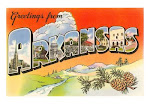POETRY BREAK: UNUSUAL FORM
Introduction: This poem is written in concrete form:
Two in Bed
by Abram Bunn Ross
When my brother Tommy
Sleeps in bed with me,
He doubles up
And makes
himself
exactly
like
a
V
And 'cause the bed is not so wide,
A part of him is on my side.
from Poetry Speaks to Children Edited by Elise Paschen, Dominique Raccah and Nikki Giovanni
Illustrators: Wendy Rasmussen, Judy Love and Paula Zinngrage Wendland
Sourcebooks MediaFusion, 2005
Two in Bed
by Abram Bunn Ross
When my brother Tommy
Sleeps in bed with me,
He doubles up
And makes
himself
exactly
like
a
V
And 'cause the bed is not so wide,
A part of him is on my side.
from Poetry Speaks to Children Edited by Elise Paschen, Dominique Raccah and Nikki Giovanni
Illustrators: Wendy Rasmussen, Judy Love and Paula Zinngrage Wendland
Sourcebooks MediaFusion, 2005
Extensions: Discuss the shape of the poem. Some questions to consider: Why did the writer arrange the lines of the poem in the v-shape? Did this add interest to the poem? Do you still like the poem even though it doesn't rhyme? Have you ever slept with someone who got on your side of the bed? Do you share a bed or your room with a sibling or someone else? Has anyone ever done anything that got in your "space"? If so, what did you do? Point out that sometimes it helps to write about frustrating things. Challenge the children to think and write about a time when someone did something annoying to them. In discussing the shape of the poem, it might be fun to act out the poem to illustrate how uncomfortable it would be to have someone doubled up in the shape of a V right next to them in bed. Maybe the children would enjoy making the shapes of other letters with their bodies. The children could pick a letter or shape and try to write a poem in that shape. Look through other poetry books to find concrete poems.
***********************************************
POETRY BOOK REVIEW: VERSE NOVEL
Your Own, Sylvia: a verse portrait of Sylvia Plath
by Stephanie Hemphill
Random House 2007

Introduction: This book is written by a poet about a poet. It is a collection of poems written in a variety of styles, from the point of view of people who knew the writer Sylvia Plath. Much has been written about Sylvia Plath, who lived from 1932-1963. Stephanie Hemphill, who wrote Your Own Sylvia, studied these writings and the works of Plath in her research for this fictional book based on truth. The result is an emotional story about a talented and tormented writer, that introduces the reader to the writings of Sylvia Plath and her short life. Readers will be hungry for more of Plath's and Hemphill's work after reading Your Own Sylvia.
Extensions: Sylvia Plath took her own life at the age of 30. After reading Your Own Sylvia, discuss the following social issues included in the book and relavent to Plath's life: suicide, depression, women's roles in society, dysfunctional families, relationships with parents, sexuality.
Discuss the different forms of poetry included in the book. For example, the poem Dysfunction (p. 223) is written in haiku. It starts out:
Hysterical at
my doorstep, no coats on the
children. No clothes, no
bottles.
She melts, hands
She melts, hands
me little Nick, will I help
her, watch them, she's sick,...
Abecedarian (p. 82) describes Plath from the point of view of a former teacher who visits her after she is hospitalized for depression. Each line begins with a different letter of the alphabet, beginning with a, b, c, and so on.
Absent as a
bear in deep winter, her mind
can't connect, her memory appears
dead. Her ace brain has switched off....
Students might enjoy experimenting with writing poetry in haiku or abecedarian style.
Students might enjoy experimenting with writing poetry in haiku or abecedarian style.
Examine interesting phrasing, especially with respect to literary ties. In Sunday Night, Monday Night, (p. 230) Sylvia's neighbor notes, with perhaps a reference to Lewis Carol's character in Alice's Adventures in Wonderland:
Whatever that Dr. Horder prescribes
makes her hatter mad tonight...
In June, 1962, Hemphill includes another literary reference, this time to Shakespeare. Sylvia's mother visits and observes:
Sivvy announces repeatedly
that happiness dances around her bed.
She has the perfect home, the perfect
children, the perfect husband.
But I believe she doth protest too heartily...
Challenge the students to find other literary references.
Sylvia Plath kept extensive journals. Students could be given a few minutes to write in journals each class period.
Encourage students to go to http://www.sylviaplathforum.com/ to learn more about Sylvia Plath; and to read more of her works including Winter Trees and Collected Poems.
***********************************************
POETRY CHOICE: POETRY THAT DOES NOT RHYME
Introduction: The following poem does not rhyme.
The Reason I like Chocolate
by Nikki Giovanni
The reason I like chocolate
is I can lick my fingers
and nobody tells me I'm not polite
I especially like scary movies
'cause I can snuggle with Mommy
or my big sister and they don't laugh
I like to cry sometimes 'cause
everybody says "whats's the matter
don't cry"
and I like books
for all those reasons
but mostly 'cause they just make me
happy
and I really like
to be happy
from A Family of Poems by Caroline Kennedy
Illustrated by Jon J. Muth
Hyperion, 2005
Extensions: Get the children's reaction to the poem. Ask if they like it even though it does not rhyme. Talk about the rhythm and pauses. Divide the class into small groups and do tandem readings, either within the groups, or having each group read a stanza. Have the children point out the things the writer likes in the poem, chocolate, scary movies and so on. Let the children discuss and write down things they like and why. Have a chocolate-y snack!



No comments:
Post a Comment